Sunday Dec 21, 2025
Sunday Dec 21, 2025
Thursday, 7 March 2024 00:35 - - {{hitsCtrl.values.hits}}
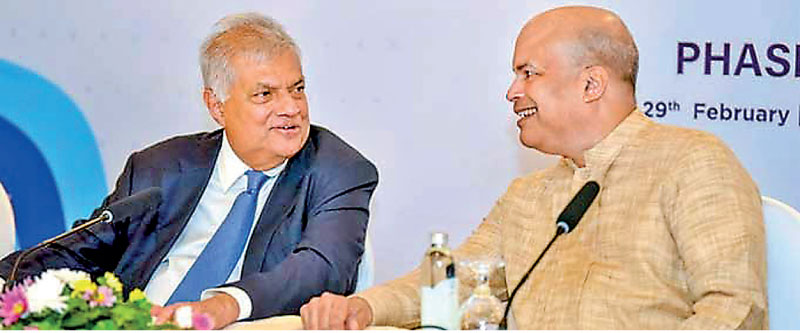
Election, what election?
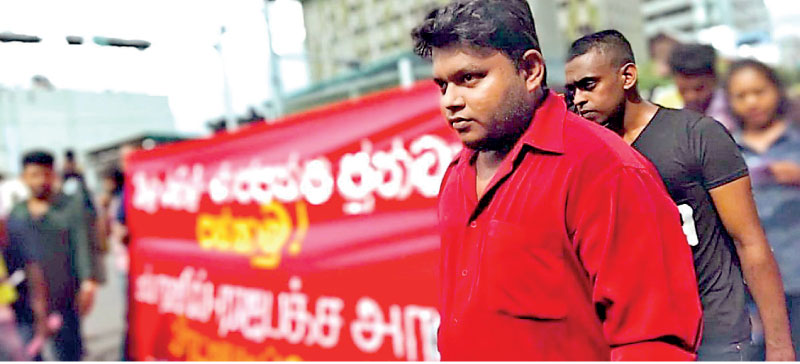
Aragalaya hero Wasantha Mudalige
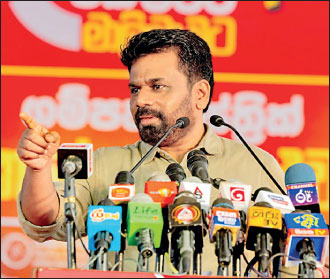
AKD’s modernity project
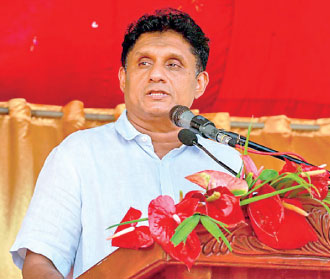
Janasaviya 2 is coming
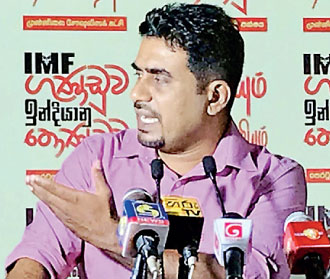
FSP’s Duminda Nagamuwa jpg
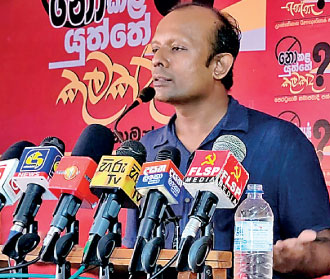
Public pedagogue: FSP’s Pubudu Jayagoda
 The secret of Anura Kumara Dissanayaka and the NPP’s success, the reason why the combination is drawing record crowds and is the only political entity in the field to do so, is really simple. It’s the public imagination, stupid!
The secret of Anura Kumara Dissanayaka and the NPP’s success, the reason why the combination is drawing record crowds and is the only political entity in the field to do so, is really simple. It’s the public imagination, stupid!
Anura and the NPP have seized the public imagination in a way that nobody in this election year has. They have done so, not by resorting to base invocations of race and religion as Gotabaya Rajapaksa did. They have done so, because they are not boring while almost all others are; they have not lost credibility as all others have; they are interesting and have social energy while the others are tired and lack authentic passion; they have a positive message which motivates and mobilises while others are shrilly negative, imaginatively timid, stale and samey.
Why NPP now?
The specific historical and social moment – the ‘conjuncture’--we’re living in, has to be understood. How did Anura and the NPP get from 3% and 3 seats, to the formation with the most traction? What changed? The zeitgeist did, after the triptych (a) pre-Aragalaya economic collapse (b) Aragalaya (c) polarising post-Aragalaya policies.
What explains the landmark defeat of the UNP and SWRD’s historic victory in 1956? The changed zeitgeist after the triptych (a) pre-Hartal economic shock (b) Hartal 1953 (c) polarising post-Hartal policies of Sir John Kotelawala. It’s come around in 2022-2024.
Certainly, the victorious SLFP-MEP was a moderate center-left, not a Marxist Left. But what was initially its contemporary progressive-populist equivalent, the SJB ( that’s why Mangala Samaraweera resigned, denouncing it as ‘MR Lite’), has since degenerated from progressive-centrism into the party of the Center-Right, publicly perceived as not basically different in economic doctrine and model from Ranil and his UNP.
In 1956, if SWRD’s SLFP had been on a seamless policy continuum or ideologically congruent with Sir John’s UNP as the SJB is with Ranil’s UNP, then the Marxist LSSP-CP would have won, surfing the Hartal. That’s happening now, because in ideology and policy, the breakaway SJB is far less demarcated and distant from Ranil’s UNP than Ranasinghe Premadasa’s UNP (late-1988 on) was from Jayewardene’s.
After the Gotabaya shock, the economic collapse and the phenomenal Aragalaya which overthrew him, the public consciousness began to perceive the parliamentarians and their parties very differently from before. They all came from the same old deck of cards; had served in successive administrations responsible for the debt-crisis; still sounded the same; offered the same ideas and ideologies as before. Suddenly they were revealed as stale, obsolete, boring; belonging to the old, failed Establishment. As a mainstream party the JVP-NPP was the sole exception. (Dullas, Charitha Herath, Sumanthiran were individual exceptions.)
The JVP didn’t lead the Aragalaya. The Aragalaya arrowhead was the Inter-University Student Federation (IUSF), guided by the radical left Frontline Socialist Party (FSP). The hero of the Aragalaya was Wasantha Mudalige, and the FSP’s Duminda Nagamuwa was an electrifying speaker. Displaying tactical brilliance and courageous, inspiring leadership, they brilliantly threw out Gotabaya and secured a major victory, without which we’d literally be starving because of the fertiliser-weedicide-pesticide ban, and dying from exploding gas cylinders. But the FSP-IUSF combine lacked the mature Leninist realism, and minus a Coordinating Council with the JVP, the sheer capacity, the heft, to secure a progressive outcome. They couldn’t outmanoeuvre or countervail the counterrevolution and economic counterreformation that Ranil represented and unleashed.
In a bitter irony of history, the Rajapaksas made a choice which was exactly the same blunder the ruling UNP made after the Hartal 1953, which enabled SWRD and his Rajapaksa allies in the South to sweep to power in 1956. After the evacuation of the Government and resignation of Prime Minister Dudley Senanayake, had the UNP chosen CWW Kannangara or MD Banda instead of Sir John as successor, 1956 may have been avoidable or much milder. But it wanted a tough ‘bouncer’ and chose Sir John. Similarly, the Rajapaksas chose Ranil Wickremesinghe, rejecting their own comrade Dullas Alahapperuma who would have coopted the Aragalaya through dialogue and consensual progressive reform.
The SLPP and MEP now face the same fate as Sirisena’s SLFP did having hooked-up with Ranil. The Rajapaksas and Gunawardenas will pay the price for betraying 1956 -- the upward escalator for those political clans-- and enthroning as President, Esmond and Nalini Wickremesinghe’s son, scion of the 1956 enemy, now charging forward with the anti-national, neo-comprador UNP project defeated by “the Silent Revolutions of 1956 and 1970”.
With all other parties either complicit in the economic crisis, or the religio-racist selling of the grotesque Gotabaya presidency, or unable to present an alternative to the incumbent (the SJB absented itself at the vote on the Ranil-IMF ‘economic contraction’ package and voted for the Central Bank ‘independence’ bill), it is Anura Kumara and the JVP-NPP that’s filled the vacuum with a new message.
Today, only the JVP-NPP and FSP-JAV (Jana Aragala Vyaparaya) discourses are interesting. Assuming the role of the old UNP, the SJB has become slow, conservative, technocratic and boring. The ruling SLPP and its factions are zombies. Jedi-warriors of the left, the FSP is no governance option.
The JVP-NPP stands alone as a credible, compellingly appealing, new political alternative. New, because the NPP is new.
Dissanayaka’s discourse
The NPP is drawing power from three currents:
 The Aragalaya spirit of liberation of youth and women.
The Aragalaya spirit of liberation of youth and women.
 The renewed hope in war veterans who saw their struggles and sacrifices for a better Sri Lanka betrayed by Gotabaya and his clique;
The renewed hope in war veterans who saw their struggles and sacrifices for a better Sri Lanka betrayed by Gotabaya and his clique;
 The realistic radicalism of Anura Dissanayaka and his JVP colleagues who, unlike all other parties have neither lost their credibility nor patronisingly overlook the intelligence and emotions of their audiences.
The realistic radicalism of Anura Dissanayaka and his JVP colleagues who, unlike all other parties have neither lost their credibility nor patronisingly overlook the intelligence and emotions of their audiences.
Anura Dissanayaka is impressively doing two contradictory things at the same time: sensitively picking up and strongly channelling the everyday grievances of the people on the ground, while flying at a higher and higher altitude and communicating broad, inspiring vistas in an election year. Relaying an eagle’s eye view to audiences about the country’s crisis and the solution, Anura is calling the citizens to a great task: simultaneously a ‘new renaissance’ (‘nava jathika punarudaya’) and a forward-looking modernity (‘noothanathvaya’), sharply critical of cultural and attitudinal nostalgia (‘atheethavaadithvaya’) and backwardness (‘pasugamithvaya’).
He is combining a deep-going critique with a sweeping vision—almost a holographic projection—of what the country could be. It is persuasive, appealing, and modernist without being boringly technocratic.
If readers think this is political romanticism, I’d request them simply to listen to a single speech by AKD at the NPP’s Matara District Lawyers Convention on March 1st 2024. (https://www.youtube.com/watch?v=5D-veLx2wCk&t=2454s)
For Anura, ours is a long crisis of nation-building and modernisation. His discourse is an indictment of the island’s inability to fulfil the twin intertwined tasks of modernisation and nation-building which have been achieved by many countries in the 20th century.
Anura identifies the structural and indeed systemic blockages as those of social and ideological backwardness—the political weaponisation of primordialism: race, religion, caste.
He then rolls out a set of ideas containing a vision of what is necessary and achievable—reforms ranging from educational changes to export diversification.
Contrary to the cliches of right-wing critics and competitors, Anura’s speech contains an accurate appreciation of the market and argues for its liberation from the grip of political and corporate oligarchies. He has a concrete critique of Sri Lanka’s political culture of governance which imitates outdated practices of monarchy and clientelism.
AKD ends his visionary speech, promising to unveil a transparent 5-year National Development Plan well before the election. (Here, his perspective coincides with the excellent ‘Forward from The Way Forward’ --’Idirimagen Idiriyata’-- released by the Communist Party and co-authored by a galaxy of economists.)
What is the essential difference between the AKD-NPP vision, and those of its rivals, President Wickremesinghe and the main parliamentary Opposition, the SJB?
 The AKD-NPP vision is of a reformed, restructured Sri Lanka which strides forward with a new internal dynamic to carve out the maximum possible space in the world market and world economy. By contrast, the composite UNP-SJB vision is of a reformed, restructured Sri Lanka which permits the maximum economic and geographic space on this small island to be occupied by the world’s players.
The AKD-NPP vision is of a reformed, restructured Sri Lanka which strides forward with a new internal dynamic to carve out the maximum possible space in the world market and world economy. By contrast, the composite UNP-SJB vision is of a reformed, restructured Sri Lanka which permits the maximum economic and geographic space on this small island to be occupied by the world’s players.
 Anura’s project seeks to optimise Sri Lanka’s global presence and participation; the UNP-SJB’s project seeks to maximise Sri Lanka’s external dependence.
Anura’s project seeks to optimise Sri Lanka’s global presence and participation; the UNP-SJB’s project seeks to maximise Sri Lanka’s external dependence.
 Intellectually, the AKD-NPP project is nationally produced (“the cake was baked at home” in Lakshman Kadirgamar’s proud phrase) and aimed at export and exploration. Intellectually, the UNP-SJB programs are externally-produced, imported and locally-assembled and distributed.
Intellectually, the AKD-NPP project is nationally produced (“the cake was baked at home” in Lakshman Kadirgamar’s proud phrase) and aimed at export and exploration. Intellectually, the UNP-SJB programs are externally-produced, imported and locally-assembled and distributed.
 The AKD-NPP vision, just as President Premadasa’s 200 garment factories program, is similar to victorious, postwar Vietnam. The UNP-SJB vision is of South Vietnam when it was a US puppet; not the victorious, reunified, Vietnam. AKD’s vision is similar to Deng Xiaoping’s modernised China; the UNP-SJB vision is of pre-revolutionary China, when it was a semi-colony, with spheres of influence carved out by the West.
The AKD-NPP vision, just as President Premadasa’s 200 garment factories program, is similar to victorious, postwar Vietnam. The UNP-SJB vision is of South Vietnam when it was a US puppet; not the victorious, reunified, Vietnam. AKD’s vision is similar to Deng Xiaoping’s modernised China; the UNP-SJB vision is of pre-revolutionary China, when it was a semi-colony, with spheres of influence carved out by the West.
 AKD’s vision is national without being narrowly nationalist; it is patriotic in the modern sense. The shared UNP-SJB vision combines free-market economic liberalism and foreignisation with religio-cultural conservatism and traditionalism.
AKD’s vision is national without being narrowly nationalist; it is patriotic in the modern sense. The shared UNP-SJB vision combines free-market economic liberalism and foreignisation with religio-cultural conservatism and traditionalism.
AKD, Sajith must retain presidency
AKD’s commitment to abolish the executive Presidency runs contrary to his vision and mission. For its realisation, Anura’s economic vision requires the directly-elected executive presidency. Overcoming the obstacles of backwardness and embarking on catch-up modernisation and reforms which will unleash ‘the forces of production’ to the maximum, cannot be done within a purely or primarily parliamentary system, with its divisions and fragmentation.
Anura’s project also requires rapid decision-making and implementation, for which the executive presidency is far superior to Parliament.
If a majority of the people of Sri Lanka choose Anura Dissanayake as President, he must not deprive the people and the nation of this powerful instrument, the directly-elected executive presidency. Instead of handing power to an easily manipulated and purchasable parliament, the JVP-NPP should make the executive presidency more truly ‘republican’ in character; more an instrument of people’s sovereignty. The President must not be elected by parliament, but remain directly chosen by the people. The Presidency must be ‘people-ised’.
The same goes for Sajith Premadasa. Sajith announced at his Tambuttegama ‘JanaPavura’ event of Feb 27th 2024, that he would unveil a new, strengthened Janasaviya program with the same four components as his late father’s iconic initiative. (YouTube) That’s excellent, but if he wins, he’d better retain the executive presidency, because if not, his Economic Council will delay, dismantle or dilute the initiative.
Anura and Sajith must bear in mind the recent experience of Chile. Its young, progressive president, ex-student leader Gabriel Boric handsomely won his election and then tried to make good on his promise of a new Constitution. That new draft was defeated at a Referendum, not once but twice, even after revisions, by the same Chilean people who had elected Boric as President. The considerations and compulsions that govern the electorate’s choice of a President are quite different from those that come into play at a referendum over a new Constitution.
As elected president, Anura or Sajith can be defeated at a Referendum by the ultranationalist opposition of Dilith Jayaweera, Anuradha Yahampath, Wimal Weerawansa, Udaya Gammanpila and Gevindu Cumaratunga, and the more mainstream defeated SLPP (containing Sarath Weerasekara). All they need do is focus on the dangers of abolishing the strong, centripetal presidency while retaining the Provincial Councils.
Anura Dissanayaka or Sajith Premadasa will find that they have expended precious time and political capital in a needless constitutional quagmire, incurring a political defeat after which they will find it difficult to regain political hegemony. Despite her magnificent 62% in 1994, Chandrika floundered after her ‘union of regions’ packages 1995-1997 and August 2000 draft Constitution were stymied. Ranil was electorally doomed by his non-unitary draft constitution of 2015-2019.
Pre-emptive parliamentary election
Ranil’s popularity is a measly 7%. The UNP is 6%. The SLPP, 7%. Even if the whole of the SLPP backed Ranil, which is increasingly unlikely, he won’t get more than 14%.
His best-case scenario is that he would be backed by the SJB. This is unlikely, but even if it were so, Ranil on 7% and Sajith on 36% would total 43%, which falls short of AKD’s 50% at a Presidential election.
After a parliamentary election, the SJB currently at 30%, the SLPP at 8% and the UNP at 6%, could conceivably coalesce (as in Pakistan) to outstrip the JVP-NPP at 40%. Perhaps this is why Dr. Harsha de Silva was so sure that a parliamentary election will be called ahead of the presidential election (around August). This overlooks the distinct possibility that the first election called will trigger a massive protest vote avalanche, turn it into a 1956-1970-1977-type triumph for the NPP because the voters will perceive it as a chance to throw the 225 rascals out and make Anura the PM.
Watching the live feed of the NPP Women’s convention Ratnapura (March 3) and the superb speech (quoting Lenin) by young lawyer Nilanthi Kottahachchi, my guess is that thanks to the unprecedented women’s mobilisation and its multiplier effect in and through workplaces, households and neighbourhoods, the NPP has the parliamentary election pretty much in the (hand) bag. (https://youtu.be/FPFJNX-2UvM). Peer-competitors of the NPP women’s movement remain in a Mahila Samithi time-warp.
Watch Ranil vigilantly
Check out photographs of Ranil Wickremesinghe, Milinda Moragoda, Nirj Deva, Indrajit Coomaraswamy et al, at the recent Indo-Lanka dialogue of the Pathfinder foundation.
Watch the footage of Ranil addressing the military at China Bay, Trincomalee. Listen to his definition of ‘the constitutional duty of the military’.
 “…The fiery mood was reflected elsewhere too…On Thursday night, he told a Sri Lanka Air Force passing out parade in Trincomalee that whether there was an internal or external problem, one should not run away but face the brunt of it...” (https://www.sundaytimes.lk/240303/columns/ranil-wants-unp-revamped-but-suspense-over-his-candidature-for-presidency-550605.html)
“…The fiery mood was reflected elsewhere too…On Thursday night, he told a Sri Lanka Air Force passing out parade in Trincomalee that whether there was an internal or external problem, one should not run away but face the brunt of it...” (https://www.sundaytimes.lk/240303/columns/ranil-wants-unp-revamped-but-suspense-over-his-candidature-for-presidency-550605.html)
What’s wrong with this picture?
Does any of this sound or look like an unelected President facing a crucial national election against the backdrop of a shrinking economy, in a few months?
Wickremesinghe looks like he is calculating the moment to make his “swerve”, circumventing the Presidential election and postponing the parliamentary election on the pretext of Constitutional and/or electoral reform.
The UNP, SLPP-Ranilists and SJB are behaving as if they expect something or someone to wield a giant eraser and efface Anura Dissanayaka and the JVP-NPP from the board.
FSP dissent
The direction and pace of ongoing economic decisions reminds me of the disastrous fire-sale of the state sector and national assets in Russia in the early 1990s under Yeltsin.
In a double-track series of public seminars by Education Secretary Pubudu Jayagoda and trade union leader Duminda Nagamuwa, the radical left FSP-JAV persuasively points to the accelerated, multi-directional penetration by, and parcelling out to, foreign capitalist interests of the island’s economic and geographic space. (https://youtu.be/A2Wh_4EdAAY?si=Aj_wrh9iDPXpnJp2)
The FSP challenges the JVP, asking how its brisk trot to an election which Ranil may or may not permit, can prevent the ongoing privatisation pandemic and relentless foreign penetration.
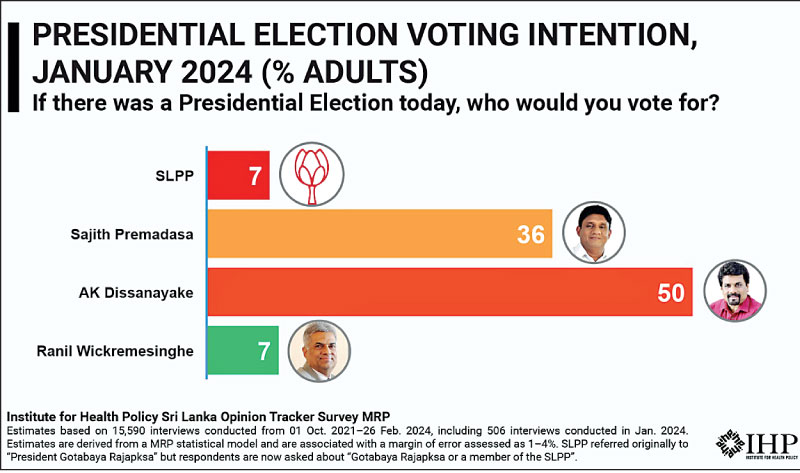
Anura 50%, Sajith 36%, Ranil 7%
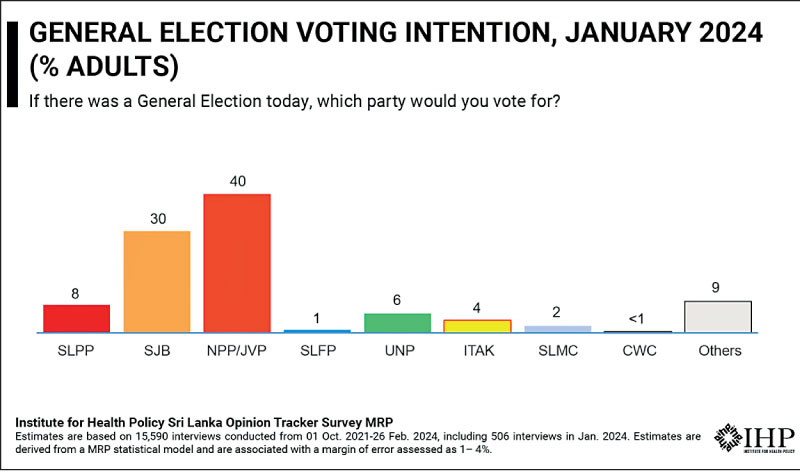
NPP 40%, SJB 30%, SLPP 8%, UNP 6%